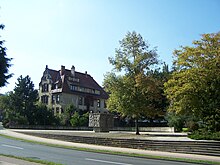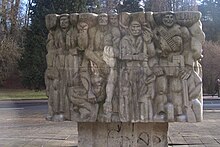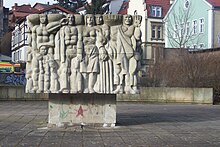Memorial to the history of the German labor movement at the Eisenach Party Conference memorial in 1869
The memorial to the history of the German labor movement at the Eisenach Party Conference 1869 memorial - also known under the propagandistic working title Party - Kraft der Klasse is a memorial in the city of Eisenach .
The memorial was erected on the southern outside area of the Eisenach Party Conference Memorial in 1969 on Wartburgallee , opposite the Kartausgarten park with the foyer. It was designed by the Erfurt artists Anke and Siegfried Besser and awarded a prize in a design competition. On March 14, 1983, the 100th anniversary of Karl Marx's death , it was inaugurated with a ceremony.
history
The internationally significant events "900th anniversary of the Wartburg " (today a world cultural heritage ), the "150. Anniversary of the Burschenschaftsfest ”and the“ 450th anniversary of the Reformation ”were celebrated in Eisenach in 1967 under the government of the GDR Ministry of Culture with a series of events. Since these three historical events were difficult to reconcile with the SED ideology, a cultural-political counterbalance had to take place in Eisenach in the same year. The opening of a planned "Eisenach Party Conference 1869 Memorial" in Eisenach was seen as the ideal solution. On August 7, 1869, the founding congress of the Social Democratic Workers' Party (SDAP) took place in Eisenach under the leadership of August Bebel and Wilhelm Liebknecht . 264 delegates from 193 locations in Germany, Austria and Switzerland discussed the establishment of a proletarian party ; it was also the largest congress in the history of the German labor movement to date.
In the renovated building complex of the former “Goldener Löwe” inn, Professor Albert Norden , a member of the Politburo of the Central Committee of the SED , inaugurated the “Eisenach Party Conference 1869” memorial at Marienstrasse 57 in the south of Eisenach's old town on March 25, 1967 .
After the commemorative year of 1967 it became clear that the intended attention for the memorial quickly waned, as the location was not noticed by tourists. The creation of a forecourt for political rallies was also planned. The choice fell on a green area adjacent to the Wartburgallee, which also belonged to the area of the memorial and blended harmoniously into the park area of the Kartausgarten opposite.
At the commemorative event organized on August 8, 1969 on the occasion of the 100th anniversary of the founding of the SDAP, Friedrich Ebert , also a member of the Politburo of the SED Central Committee, laid the foundation stone for the national monument on the history of the German labor movement at the Eisenach Party Congress 1869 memorial. A competition was announced for the design of the area, which was won by the Erfurt artist couple Anke and Siegfried Besser . The memorial was inaugurated on March 14, 1983, the 100th anniversary of Karl Marx's death .
description
Design specifications for the monument
The artist couple Besser had already designed sculptures and monuments on behalf of the state before the Eisenach monument was designed. Looking back on her work, Anke Besser described the client's expectations and objectives:
“When we took on the order for an artistic sculptural design in 1972 to honor the historical event of 1869, the client's request was to create a monument with a monumental character for this specific space. There was a unified view not only of looking for a reference to the concrete historical occasion, but also of drawing a bow in the development of the party of the working class up to the present day. The desired monumental effect, which should not be understood solely as a question of spatial size, resulted from the historical dimension, from the general statement: "Party - power of class". The aim was to show the development of the party from its beginnings to the revolutionary mass party of today. The aim was to illustrate the victoriousness of the struggle in an artistically appropriate plastic form, without denying the severity, the sacrifices, from which the historical achievement arises. "
construction
The spatial conditions of the location are reminiscent of the heyday of Eisenach as a former residence city under Grand Duke Carl Alexander - whose bronze monument is about 100 m south on the driveway to the Wartburg and of the spa episode, which includes some hotels, parks, villas and the foyer still clearly manifested in the southern quarter. The design of the monument in this area of tension of past splendor required a sensitive solution in order not to let the work appear as a foreign body.
The surrounding square of the monument is separated from the adjacent green space by a low wall ("wall of writing"), and Bertolt Brecht's poem Praise the Party was used as a relief-like banner on the front side .
- THE SINGLE HAS TWO EYES
- THE PARTY HAS A THOUSAND EYES.
- THE PARTY SEES SEVEN STATES
- THE INDIVIDUAL SEES A CITY.
- THE INDIVIDUAL HAS HIS HOUR,
- BUT THE PARTY HAS MANY HOURS.
- THE INDIVIDUAL CAN BE DESTRUCTED,
- BUT THE PARTY CANNOT BE DESTRUCTED.
- BECAUSE SHE IS THE FOREGROUND OF THE MASSES
- AND LEAD YOUR FIGHT
- WITH THE METHODS OF THE CLASSICS THAT ARE CREATED
- FROM KNOWLEDGE OF REALITY.
The wall consists of the same building material as the monument and serves as a means of designing the space, it creates the distance required by the monument to the green area and the wider environment.
The main face of the sculpture was oriented towards the Wartburgallee. There is a chronological order of the four picture panels, which the visitor can look at in a clockwise direction.
The first plaque bears the year 1869 and commemorates the founding of the Social Democratic Workers' Party in Eisenach.
"Out of social misery (worker woman on the left - the reference to a Käthe Kollwitz drawing" Hunger "is intended) and oppression (tied up on the right) the revolutionary part of the working class" man of work woke up and recognize your strength! " Man with the hammer - based on the artistic self-portrayal of the working class of that time). When it comes to the two spiritual leaders, one might think of Bebel and Liebknecht, the founders of the Social Democratic Workers' Party. "
The second plaque bears the year 1918 and commemorates the founding of the Communist Party of Germany .
“The central figure on this panel is a worker woman with the flag. One thinks of Maxim Gorki's "mother". The thought of the Great October Socialist Revolution resonates. The two corner figures symbolize heroic achievements of the working class during this time. The sailor on the right stands for the November Revolution . The Spanish fighter on the left brings in the idea of international solidarity. The figure of the collapsing and the one holding him associate the resilience and the victims of the German working class and its party in the night of fascism. "
The third plaque bears the year 1946 and commemorates the founding of the SED.
“As a result, the two figures with the historical handshake are the focus of this part. These were the years in which the first German workers 'and peasants' state was built . The rubble woman as a legendary symbol for this is indispensable. The youth as an active co-designer is embodied in the figure of the girl. The worker in battle group uniform makes it clear that the working class knows how to protect the power it has won, is no longer defenseless and tied up. "
The fourth panel bears the year 1983 and commemorates the inauguration of the monument.
“The fourth, the front page, marked by the date of the handover of this monument, is the present and the future. Socialism advances (female figure). The ideas of Marxism-Leninism are spreading (figure of the caller). The party of the working class in the GDR is an active participant in the international class struggle. The Vietnamese woman on the left, the African woman and the Chilean raising his hand to form a sign of victory illustrate internationalism and confidence in victory. "
realization
Construction began on August 1, 1982 at the Wartburgallee location. In the presence of Eisenach's mayor Joachim Klapczynski , the head of the memorial site Hüther and Ms. Bessers, a document box with materials on the history of the memorial and daily newspapers was built into the foundation. The cuboids made of Cotta sandstone by VEB Elbenaturstein Dresden were placed on the already prepared base ; they have a total weight of 32 tons.
Todays situation
The monument was designated as a cultural monument of the city of Eisenach and has since been weathered as a testimony to the GDR state ideology. For many Eisenachers, the monument is a memorial to the conquered “concrete communism”. The monument shows minor damage, a restoration is not planned in the foreseeable future.
literature
- Anke Besser, Siegfried Besser, Joachim Klapczynski , Dieter Demme, et al .: Memorial on the history of the German labor movement at the Eisenach Party Conference memorial in 1869 . Ed .: Council of the District of Erfurt. Printer Progress, Erfurt 1983, p. 16 .
- Heinrich Weigelt, Bernd Mähler: Gardens, parks and park-like valleys and forest areas in the Eisenach district . Ed .: Stadtinformation Eisenach. Frisch Druckerei, Eisenach 1985, p. 16-28 .
Individual evidence
- ^ Herlind Reiss: City of Eisenach. Villas and country houses at the foot of the Wartburg . In: Thuringian State Office for Monument Preservation and Archeology (Ed.): Monument topography BRD. Cultural monuments in Thuringia . tape 2.1 . E. Reinhold-Verlag, Altenburg 2006, ISBN 3-937940-24-3 , p. 220-221 .
- ↑ a b c d e Anke Besser, Siegfried Besser, Joachim Klapczynski , Dieter Demme and others: Memorial to the history of the German workers' movement at the Eisenach Party Conference memorial in 1869 . Ed .: Council of the District of Erfurt. Printer Progress, Erfurt 1983, p. 16 .
- ^ NN: Monument assembly has started . In: The people . Erfurt August 3rd 1982.
Web links
Coordinates: 50 ° 58 ′ 6.4 ″ N , 10 ° 19 ′ 22.3 ″ E






